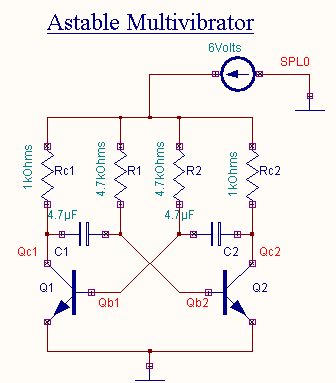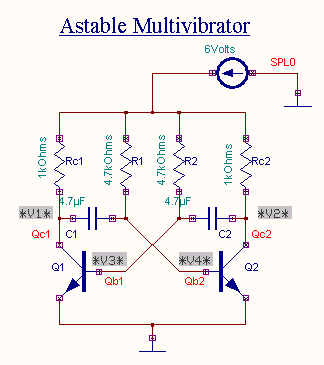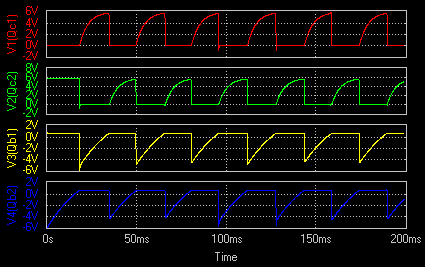Astable Multivibrator
Aim
To design and simulate an Astable Multivibrator circuit.
Components
Name |
EDWin Components Used |
Description |
Number of components required |
| BC107 | BC107A | Transistor | 2 |
| RES | RC05 | Resistor | 4 |
| CAP | CASE-A600 | Capacitor | 2 |
| VDC | VDC | Dc voltage source | 1 |
| GND | SPL0 | Ground | 1 |
Theory
Astable Multivibrator is a two stage switching circuit in which the output of the first stage is fed to the input of the second stage and vice versa. The outputs of both the stages are complementary. This free running multivibrator generates square wave without any externaltriggering pulse. The circuit has two stable states and switches back and forth from one state to another, remaining in each state for a time depending upon thedischarging of the capacitive circuit.
The multivibrator is one form of relaxation oscillator, the frequency of which may be controlled by external synchronizing pulses.
In our experiment we are using transistor, as the amplifying device and also it is a collector coupled multivibrator.

Figure shows the basic symmetrical astable multivibrator in which components in one half of a cycle of the circuit are identical to their counterpart in the other half. Square wave output can be obtained from the collector point of Q1 or Q2.
Operation
When supply voltage, VCC is applied, one transistor will conduct more than the other due to some circuit imbalance. Initially let us assume that Q1 is conducting and Q2 is cut-off. Then VC1, the output of Q1 is equal to VCESAT which is approximately zero and VC2 is equal to VCC. At this instant C1 charges exponentially with the time constant R1C1 towards the supply voltage through R1 and correspondingly VB2 also increases exponentially towards VCC. When VB2 crosses the coupling voltage Q2 starts conducting and VC2 falls to VCESAT. Also VB1 falls due to capacitive coupling between collector of Q2 and base of Q1, thereby driving Q1 into OFF state. The rise in voltage VC1 is coupled through C1 to the base of Q2 causing a small overshoot in voltage VB2. Thus Q1 is OFF and Q2 is ON. At this instant the voltage levels are: VB1 is negative, VC1=VCC, VB2=VBESAT and VC2=VCESAT.
When Q1 is OFF and Q2 is ON the voltage VB1 increases exponentially with a time constant R2C2 towards VCC . Therefore Q1 is driven to saturation and Q2 to cut-off. Now the voltage levels are:
VB1=VBESAT, VC1=VCESAT, VB2 is negative and VC2=VCC.
From the above it is clear that when Q2 is ON the falling voltage VC2 permits the discharging of capacitor C2 which inturn drives Q1 into cut-off. The rising voltage of VC1 is fed back to the base of Q2 tending to turn it ON. This process is regenerative.
Derivation of time period
The charging equation for a capacitor is given by
Capacitor voltage,
![]()
Hence
![]()
where VC - the capacitor voltage,
VINIT – the initial capacitor voltage,
VFIN – the final capacitor voltage
t – the time period of charging.R and C – the resistor and capacitor through which charging occurs.
The capacitor discharges from –VCC to VCC.
Therefore VIN=(-VCC), VFIN=VCC, VC@0V.
Substituting this in equation (2)
![]()
![]()
![]()
Taking natural logarithm,
![]()
![]()
For a symmetrical astable multivibrator,
![]()
Charging and discharging time periods are given by,
![]()
![]()
From equation(5)
![]()
where T is the total time period.
Since the multivibrator is symmetrical ![]()
Design
Design Specifications
![]()
Manufacturer’s specifications
![]()
![]()
![]()
Applying KVL for the collector side of Q2.
![]()
![]()
![]()
![]() , (since it is a symmetrical astable multivibrator)
, (since it is a symmetrical astable multivibrator)
Applying KVL for the base loop of the circuit
![]()
![]()

![]() , (since it is a symmetrical astable multivibrator.)
, (since it is a symmetrical astable multivibrator.)
Design of C
The total time period T is given by
![]()
![]() ,(since it is a symmetrical astable
multivibrator.)
,(since it is a symmetrical astable
multivibrator.)
![]()
From equations (1) and (2)
![]()
The free running frequency is given by
![]()
Assume the frequency as 100Hz.
![]()
![]()
![]()
Procedure
EDWinXP-> Schematic Editor:The circuit diagram is drawn by loading components from the library. Wiring and proper net assignment has been made. The values are assigned for relevant components.

EDWinXP-> Mixed Mode Simulator: The circuit is preprocessed. The desired test points and waveform markers are placed. The Transient Analysis parameters have been set. The Transient Analysis is executed and output observed in Waveform Viewer.
Result
The output waveform may be observed in the waveform viewer.
